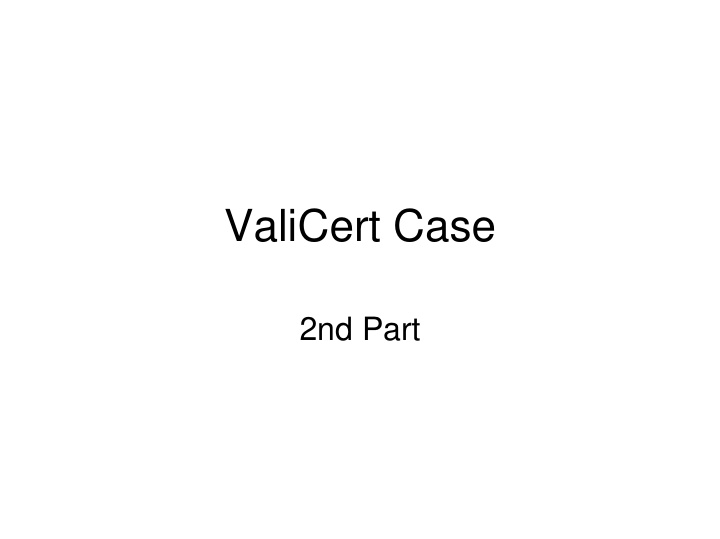



ValiCert Case 2nd Part
Exercise Questions on the ValiCert Case 1. Please describe: � What went wrong? � What were inappropriate expectations and decisions taken? 2. What would you propose to ValiCert at this stage, based on what you have learned in the course? Chair of Softw are Engineering
Exercise - 6 W hat Happened after Autum n 2 0 0 2 Vigouroux agreed to rehire one engineer in California. When he learned of the decision, Vutukuri says he felt as if he had failed. By contrast, Matt Lourie, who heads ValiCert's other big programming group, welcomed additional help in India. He was struggling to keep pace with customer demands for new features on his product and new versions for different types of computers. At the same time, ValiCert executives were streamlining operations and changing how they divided work between California and India. They gave the India team entire projects - - such as creating a PC version of a program initially built for bigger workstations -- rather than small pieces of larger projects. U.S. managers began writing more detailed specifications for each assignment to India. ValiCert also killed its three smallest-selling products to focus resources on the remaining two. To improve morale in the U.S., Vigouroux crowded the remaining employees into one corner of the half-vacant office and installed a ship's bell that he rang each time ValiCert recorded $10,000 in revenue. He made sure the India employees received companywide e-mails and conducted multiple sessions of monthly employee meetings so the India group could listen at a convenient hour. Engineering-team leaders began conferring twice a week by telephone, shifting the time of the calls every six months so that it's early morning in one office and early evening in the other. Toward the end of 2002, Vigouroux began to ring the bell daily, as customers such as Washington Mutual Inc. and MasterCard International Inc. purchased ValiCert's software. By early the next year, ValiCert executives believed the company had stabilized. Revenue increased to $3 million in the fourth quarter of 2002, up 27% from the previous quarter. Expenses declined, and the company neared profitability. Investors detected a pulse, and the stock rose to 46 cents on the Nasdaq Stock Market at the end of January, from a low Chair of Softw are Engineering of 20 cents in August 2002.
Exercise - 7 But with just $3 million in cash, ValiCert remained precarious. Vigouroux started meeting with potential new investors and began talks with Tumbleweed CEO Jeffrey C. Smith. Tumbleweed had also been through significant layoffs and retrenchment, and in February 2003, the companies agreed to merge. The combined Redwood City, Calif.- based company's 150 engineers today are almost evenly divided among California, the Tumbleweed operation in Bulgaria and the India office started by ValiCert. In Bulgaria, engineers write and test software, and scan millions of e-mails daily for traces of spam. In India, engineers test software, fix bugs and create new versions of one product. Last September, Tumbleweed released its first product developed entirely in India, a program that lets two computers communicate automatically and securely. Marur's team had worked on it for over for 18 months. Core development for new products remains in California, where engineers are closer to marketing teams and Tumbleweed's customers. Since July, Lourie's U.S. team has grown to nine engineers, from six. Tumbleweed's fourth-quarter revenue grew 69% from a year earlier, as its net loss shrank to $700,000, and cash increased by $2.4 million. Shares have risen fivefold in the past year. Brent Haines, 36, is a new hire. He joined in October as a $120,000-a-year software architect, charged largely with coordinating the work of the U.S. and India teams. That often means exchanging e-mail from home with engineers in India between 11 p.m. and 3 a.m. California time, as Haines reviews programming code and suggests changes. Such collaboration requires extensive planning, he says, "something very unnatural to people in software." "Nine months ago, people would have said [ moving offshore] was the biggest ... disaster," says Thielens, the product manager. "Now we're starting to understand Chair of Softw are Engineering how we can benefit."
Exercise – 8 (end) Lessons Leaned "At times, we were thinking, What have we done here?" recalls John Vigouroux, who joined ValiCert in July 2002 and became CEO three months later. Shifting work to India eventually did help cut ValiCert's engineering costs by two-thirds, keeping the company and its major products alive -- and saving 65 positions that remained in the U.S. But not before ValiCert experienced a harrowing period of instability and doubt, and only after its executives significantly refined the company's global division of labor. The successful formula that emerged was to assign the India team bigger projects, rather than tasks requiring continual interaction with U.S. counterparts. The crucial jobs of crafting new products and features stayed in Silicon Valley. In the end, exporting some jobs led to adding a small but important number of new, higher-level positions in the U.S. In February 2003, ValiCert agreed to be acquired by Tumbleweed Communications Corp., a maker of antispam software with its own offshore operation in Bulgaria. Today, the combined Tumbleweed is growing and again hiring software architects in Silicon Valley with six-figure salaries, as well as engineers overseas. Without India, Vigouroux says, "I don't know if we'd be around today." ValiCert's experience offers important insights into the debate over the movement of service jobs to lower-cost countries such as India. Such shifts can save companies money and hurt U.S. workers. But the process is difficult, and the savings typically aren't as great as a simple wage comparison suggests. Some jobs can't easily or profitably be exported, and trying to do so can risk a customer backlash. In recent months, Dell Inc. and Lehman Brothers Holdings Inc., for example, moved several dozen call center and help desk jobs back to the U.S. after employee and customer complaints. Chair of Softw are Engineering
Recommend
More recommend